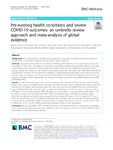2021-08-27Zeitschriftenartikel
Pre-existing health conditions and severe COVID-19 outcomes: an umbrella review approach and meta-analysis of global evidence
Treskova-Schwarzbach, Marina
Haas, Laura
Reda, Sarah
Pilic, Antonia
Borodova, Anna
Karimi, Kasra
Koch, Judith
Nygren, Teresa
Scholz, Stefan
Schönfeld, Viktoria
Vygen-Bonnet, Sabine
Wichmann, Ole
Harder, Thomas
Background
This study applies an umbrella review approach to summarise the global evidence on the risk of severe COVID-19 outcomes in patients with pre-existing health conditions.
Methods
Systematic reviews (SRs) were identified in PubMed, Embase/Medline and seven pre-print servers until December 11, 2020. Due to the absence of age-adjusted risk effects stratified by geographical regions, a re-analysis of the evidence was conducted. Primary studies were extracted from SRs and evaluated for inclusion in the re-analysis. Studies were included if they reported risk estimates (odds ratio (OR), hazard ratio (HR), relative risk (RR)) for hospitalisation, intensive care unit admission, intubation or death. Estimated associations were extracted from the primary studies for reported pre-existing conditions. Meta-analyses were performed stratified for each outcome by regions of the World Health Organization. The evidence certainty was assessed using GRADE. Registration number CRD42020215846.
Results
In total, 160 primary studies from 120 SRs contributed 464 estimates for 42 pre-existing conditions. Most studies were conducted in North America, European, and Western Pacific regions. Evidence from Africa, South/Latin America, and the Eastern Mediterranean region was scarce. No evidence was available from the South-East Asia region. Diabetes (HR range 1.2–2.0 (CI range 1.1–2.8)), obesity (OR range 1.5–1.75 (CI range 1.1–2.3)), heart failure (HR range 1.3–3.3 (CI range 0.9–8.2)), COPD (HR range 1.12–2.2 (CI range 1.1–3.2)) and dementia (HR range 1.4–7.7 (CI range 1.2–39.6)) were associated with fatal COVID-19 in different regions, although the estimates varied. Evidence from Europe and North America showed that liver cirrhosis (OR range 3.2–5.9 (CI range 0.9–27.7)) and active cancer (OR range 1.6–4.7 (CI range 0.5–14.9)) were also associated with increased risk of death. Association between HIV and undesirable COVID-19 outcomes showed regional heterogeneity, with an increased risk of death in Africa (HR 1.7 (CI 1.3–2.2)). GRADE certainty was moderate to high for most associations.
Conclusion
Risk of undesirable COVID-19 health outcomes is consistently increased in certain patient subgroups across geographical regions, showing high variability in others. The results can be used to inform COVID-19 vaccine prioritisation or other intervention strategies.
Dateien zu dieser Publikation

